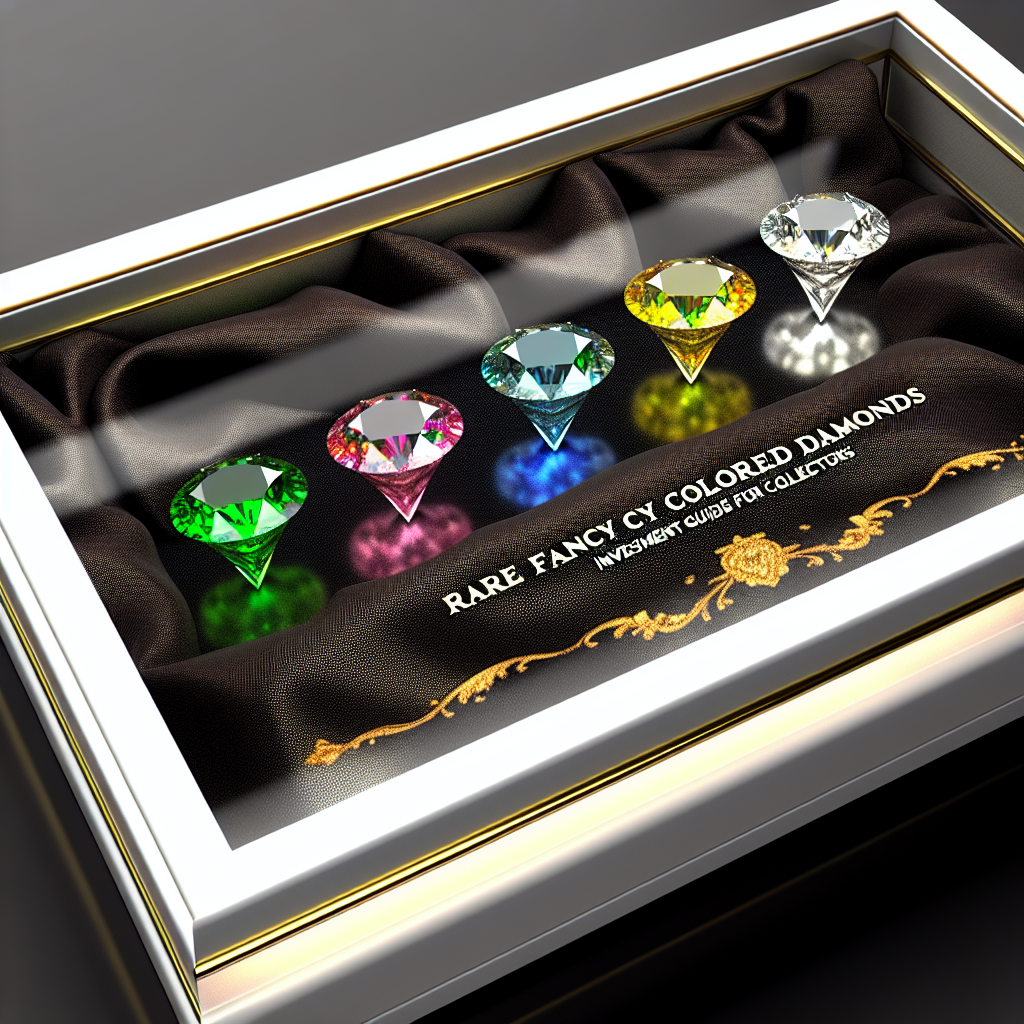Rare Fancy Colored Diamonds: Investment Guide for Collectors
Introduction
For centuries, diamonds have been celebrated as the pinnacle of wealth, status, and sophistication. While traditional white diamonds remain a mainstay in fine jewelry and investment collections, it is the rare fancy colored diamonds that have captivated the world’s most discerning collectors. These exquisite stones, prized for their rarity, unique hues, and incredible value appreciation, are much more than beautiful adornments—they are financial assets of unparalleled distinction.
Unlike white diamonds, which are graded based on clarity and cut, fancy colored diamonds derive their value primarily from hue, saturation, and intensity. The rarer and more vibrant the color, the more valuable the diamond. Colors like blue, pink, green, violet, and especially red are among the most sought-after in the world. With growing demand and diminishing supply, these diamonds have not only appreciated steadily in value over the years but have also outperformed many traditional investments such as stocks, bonds, and even gold.
A significant driving force behind the surge in interest for fancy colored diamonds is their scarcity. According to the Gemological Institute of America (GIA), less than 0.1% of diamonds mined worldwide display natural color. Additionally, certain origins, such as the now-defunct Argyle Mine in Australia, have produced some of the most vivid pink and red diamonds ever discovered, making them even more valuable. As collectors and investors recognize the long-term potential of these exceptional gems, major auction houses like Sotheby’s and Christie’s continue to break records, with colored diamonds fetching astronomical prices.
For those considering adding fancy colored diamonds to their portfolio, understanding the market dynamics, color grading, and investment potential is crucial. This guide will provide insights into the most valuable fancy colored diamonds, their scientific formation, professional grading techniques, and expert-backed strategies for prudent investment. Whether you’re a seasoned investor or a new entrant seeking a luxurious yet practical asset, this guide will help you navigate the fascinating world of rare fancy colored diamonds with confidence.
The Science Behind Fancy Colored Diamonds: Formation and Rarity
Fancy colored diamonds derive their mesmerizing hues from unique chemical elements and structural anomalies that occur over millions, if not billions, of years. Unlike traditional white diamonds—composed almost entirely of carbon—the presence of trace elements influences the coloration in fancy diamonds. For instance, boron impurities create the captivating blue hue in diamonds like the legendary Hope Diamond, while nitrogen imparts yellow and orange tones. Meanwhile, natural irradiation and lattice distortions contribute to rare colors like green and pink.
One of the rarest colored diamonds is the red diamond, which, unlike other colors, has no known chemical impurity influence. Scientific studies suggest it is the result of plastic deformation during the diamond’s formation deep within the Earth’s mantle. Less than 30 natural red diamonds have ever been discovered, making them one of the most valuable diamonds per carat on the market. In 2023, Sotheby’s auctioned an 11.15-carat red diamond for a record $14.8 million, further solidifying its investment potential.
How Fancy Colored Diamonds Are Graded and Valued
The Gemological Institute of America (GIA) is the leading authority on diamond grading, categorizing fancy colored diamonds based on three key characteristics: hue, tone, and saturation. The intensity of a diamond’s color can range from “Faint” to “Fancy Deep,” with deeper hues commanding higher prices. While secondary undertones impact value, pure, vivid colors without modifiers (such as a blue diamond without a green undertone) are considered the most valuable.
A study published by the GIA emphasizes that less than 1 in 10,000 diamonds mined globally is a fancy colored diamond, and only a fraction of those possess the natural vibrancy and saturation to be deemed investment-grade. This rarity ensures that demand remains consistently high, with luxury brands like Cartier and Graff prominently featuring these diamonds in high-jewelry collections.
Auction data indicates that pink and blue diamonds consistently achieve record prices. The Pink Star, a 59.6-carat pink diamond, sold for an astonishing $71.2 million at Sotheby’s in 2017, while the Blue Moon, a 12.03-carat vivid blue diamond, fetched $48.4 million at Christie’s. These auction results highlight the robust investment case for top-grade fancy colored diamonds.
Investment Insights: Market Trends and Pricing Growth
Investing in fancy colored diamonds requires an acute understanding of market trends, provenance, and long-term appreciation. Unlike commodities such as gold, whose valuation fluctuates with market conditions, colored diamonds have shown consistent value growth over the decades. According to the Fancy Color Research Foundation (FCRF), investment-grade fancy colored diamonds have increased annually by 8%-12% over the past two decades.
Diversification within the diamond market is key for collectors. While pink and blue diamonds remain safe-haven investments, emerging interest in violet, green, and chameleon diamonds (which change hues based on lighting) presents a lucrative opportunity for those looking to enter the market with potential future appreciation. Additionally, ownership of these diamonds comes with low maintenance costs compared to traditional real estate investments, making them an appealing asset for high-net-worth individuals.
When purchasing a fancy colored diamond, it is crucial to source from reputable dealers or auction houses that provide GIA certification. Given the prevalence of treated or lab-created colored diamonds, authentication and provenance can significantly impact long-term value. Investors should also consider safe storage solutions such as private vaults or investing in high-end jewelry settings that preserve the stone’s integrity while enhancing its wearability and resale potential.
Conclusion: The Ultimate Luxury Investment
Rare fancy colored diamonds stand as one of the most exquisite and financially rewarding investments within the luxury market. With their limited global supply, consistent value appreciation, and unparalleled beauty, these precious gems offer a unique combination of aesthetic elegance and financial security. Whether acquiring them for personal enjoyment or strategic investment, understanding the science, grading standards, and market trends associated with these treasures is essential. High-quality fancy colored diamonds will continue to dominate the world of elite gemstone collecting, making them a coveted choice for sophisticated investors who appreciate rarity, exclusivity, and long-term financial growth.
Summary:
Rare fancy colored diamonds are a unique investment opportunity that offer both aesthetic appeal and long-term financial growth. With their limited global supply, vibrant hues, and consistent value appreciation, these precious gems are sought after by discerning collectors and investors. Understanding the science behind their formation, professional grading techniques, and market trends is crucial for those considering adding fancy colored diamonds to their portfolio.
References:
– [GIA](https://www.gia.edu)
– [Sotheby’s](https://www.sothebys.com)
– [Christie’s](https://www.christies.com)
– [FCRF](https://www.fcresearch.org)

Dominic E. is a passionate filmmaker navigating the exciting intersection of art and science. By day, he delves into the complexities of the human body as a full-time medical writer, meticulously translating intricate medical concepts into accessible and engaging narratives. By night, he explores the boundless realm of cinematic storytelling, crafting narratives that evoke emotion and challenge perspectives. Film Student and Full-time Medical Writer for ContentVendor.com




